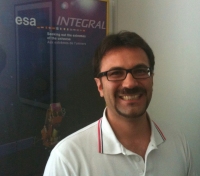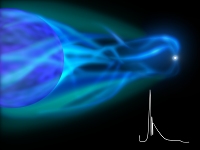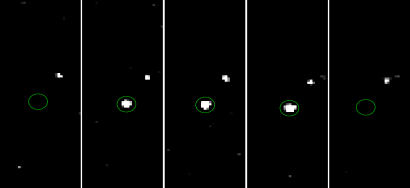INTEGRAL researcher scoops Zeldovich Medal
22 June 2010
Dr. Vito Sguera, a young, Italian scientist who contributed significantly to the discovery of a new sub-class of X-ray binaries, using ESA's INTEGRAL telescope, has been awarded the 2010 Zeldovich Medal from the Committee on Space Research (COSPAR). He is being recognised for his work on Supergiant Fast X-ray Transients (SFXTs).
 |
|
Dr. Vito Sguera. Credit: ESA |
For a long time such systems were unknown to researchers, as their emissions were shrouded in the dust lanes that sweep out the spiral arms of the Milky Way. However, INTEGRAL played a key role in the initial discovery of these stellar beasts, as its operating energy of 20 keV and above allowed astronomers to peer through the debris.
Once the first SGXB was discovered a clutch of others followed; all of them persistent X-ray sources. However, Sguera found one that displayed a rather different behaviour; a short, sharp outburst of X-rays typically lasting just a few hours followed by months of X-ray silence.
 |
|
Illustration of an SFXT source. |
"The behaviour of these objects was quite remarkable," says Vito Sguera, a researcher at the Instituto di Astrofisica Spaziale e Fisica Cosmica in Bologna, Italy. "For most of the time they were quite 'lazy' and didn't do much and then suddenly they would erupt into life." The increase in flux during such flaring was marked, increasing a thousand-fold during the outburst. Due to this inconstant and impetuous nature, his new sub-class was called Supergiant Fast X-ray Transients.
"Only with INTEGRAL was it possible to know that these sources existed," notes INTEGRAL Project Scientist, Chris Winkler. INTEGRAL's trump card is its particular combination of a large field of view - often 100 square degrees - and a high sensitivity over a broad energy band. This, coupled with the fact that INTEGRAL surveys the same part of the sky for extended periods of time, means glimpses of rare events such as SFXTs don't fall through INTEGRAL's cosmic net.
 |
|
INTEGRAL/ISGRI detection of a Supergiant Fast X-ray Transient, XTE J1739-302. |
It is this discovery of SFXTs that Scientific Commission E of COSPAR is recognising, by awarding Sguera the 2010 Zeldovich Medal, an award Winkler is convinced is justified. "It is always very exciting to find a new class of star and to have to start thinking about a model which could explain these outbursts," he said. "This discovery might be an important link in understanding how binary systems evolve. Perhaps this fast-transient phase is an important snapshot of their life," he added.
Since Sguera's discovery several theories have surfaced which attempt to explain SFXTs. One popular scenario points to a stellar wind produced by the supergiant. If this stellar wind is non-homogeneous then clumps of it, accreting onto the compact object (which may well be a neutron star), could account for the luminous and transient nature of SFXTs.
The Zeldovich Medal is conferred by COSPAR and the Russian Academy of Sciences in memory of the distinguished Soviet astrophysicist Yakov B. Zeldovich. The medal that bears his name will be presented to Dr. Sguera during the 38th COSPAR scientific assembly in Bremen, Germany (18-25 July 2010). This award, which is given to young scientists - under 35 years of age - recognises those who have demonstrated excellence and achievement in their field of research. "I am deeply honoured and grateful to receive such a prestigious award," acknowledges Sguera. "It is a reward for all the hard work, and it also gives me an additional incentive to work even harder. Although this award is given to individuals, I have the honour of sharing it with all my collaborators. It is all about team work, which makes this award even more meaningful," he adds.
|
Citation for award |

